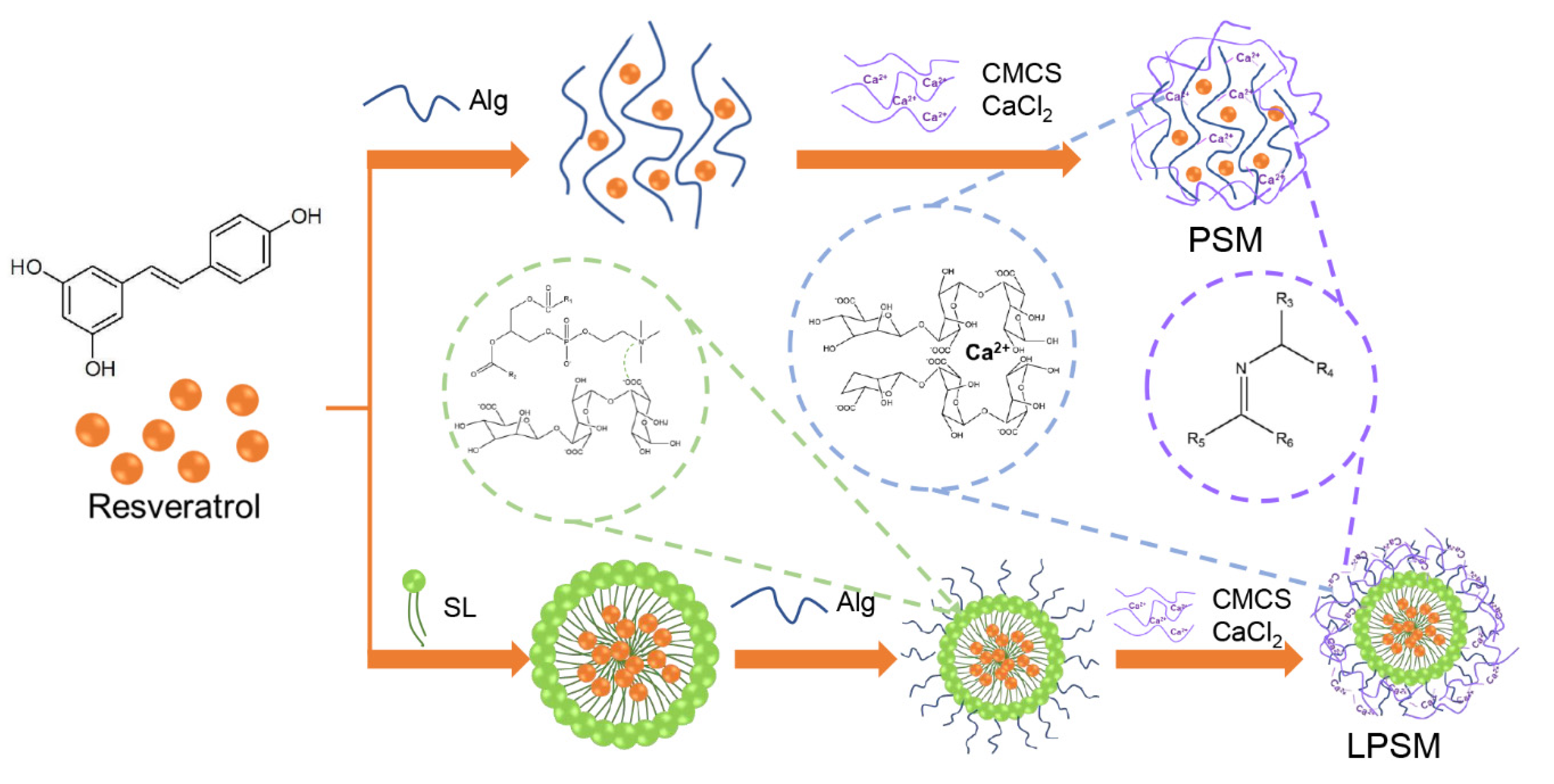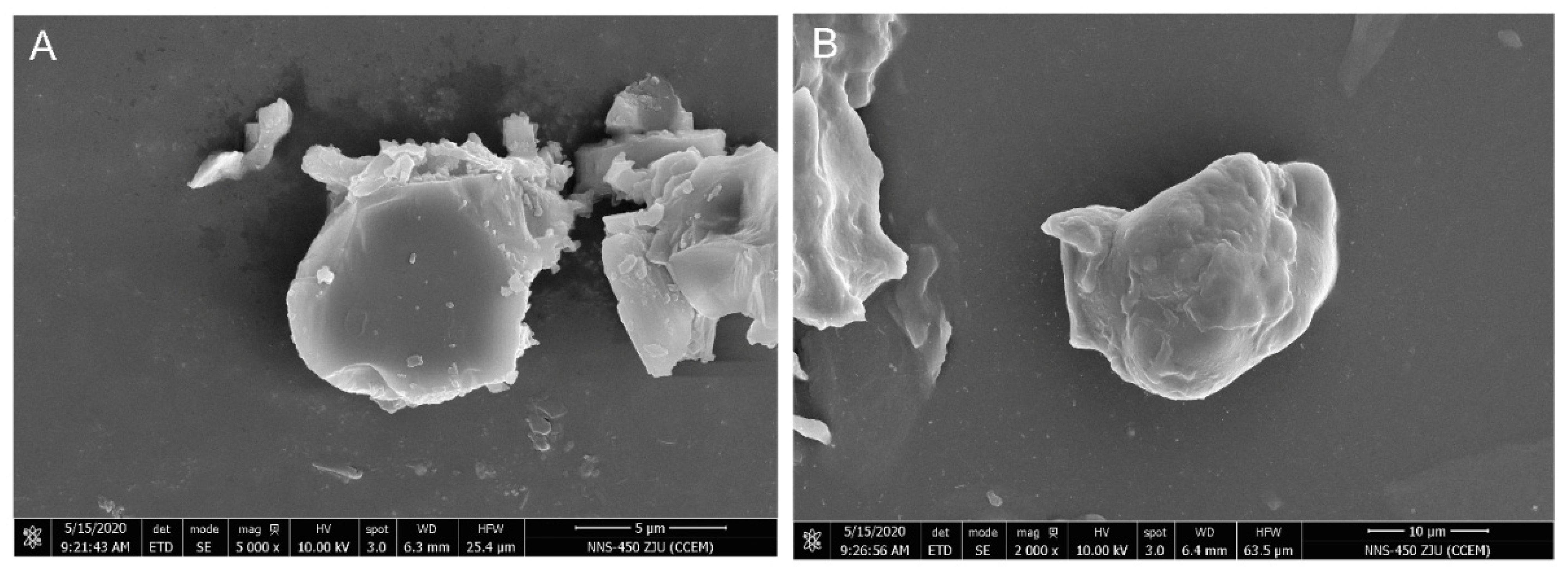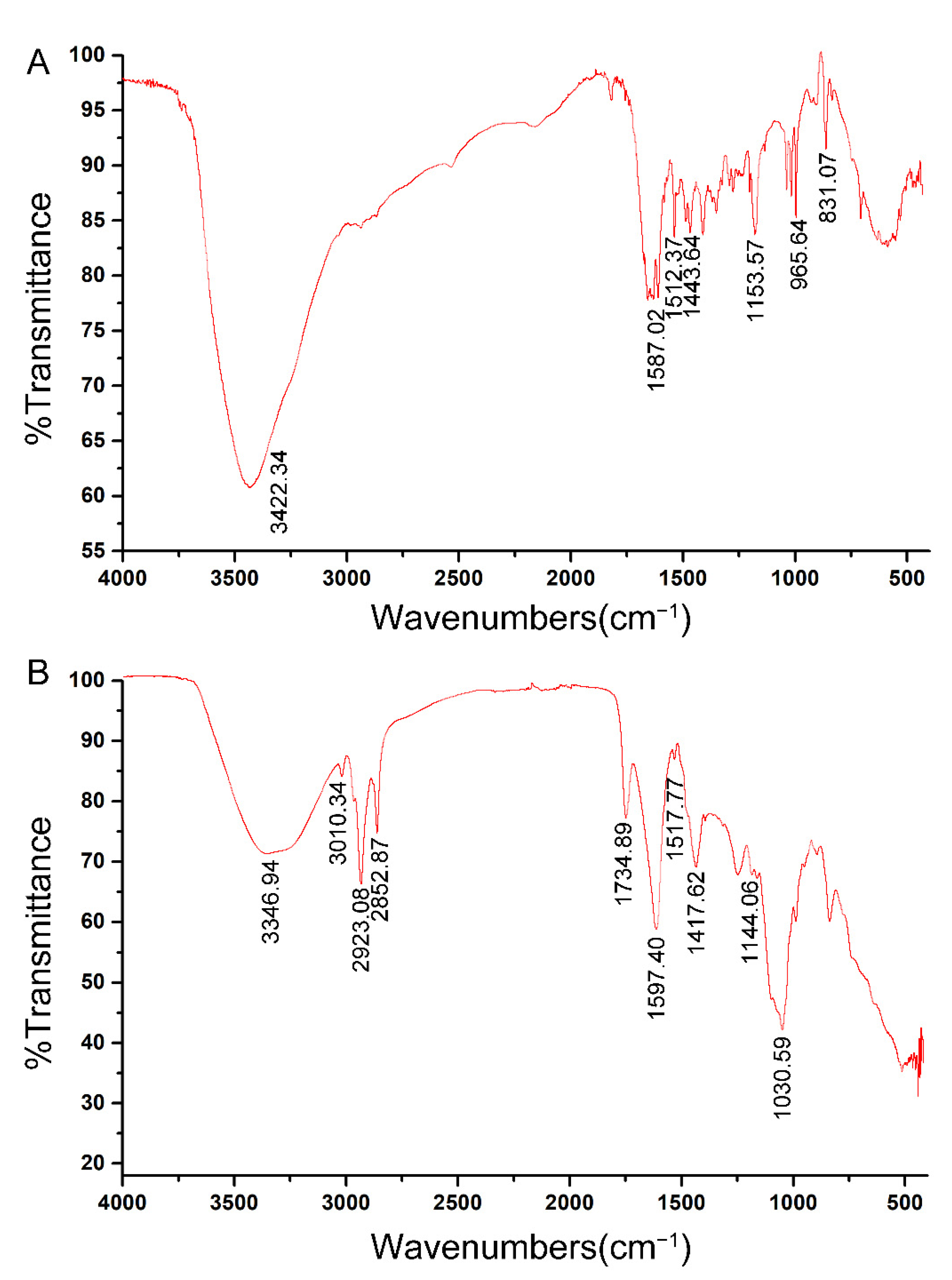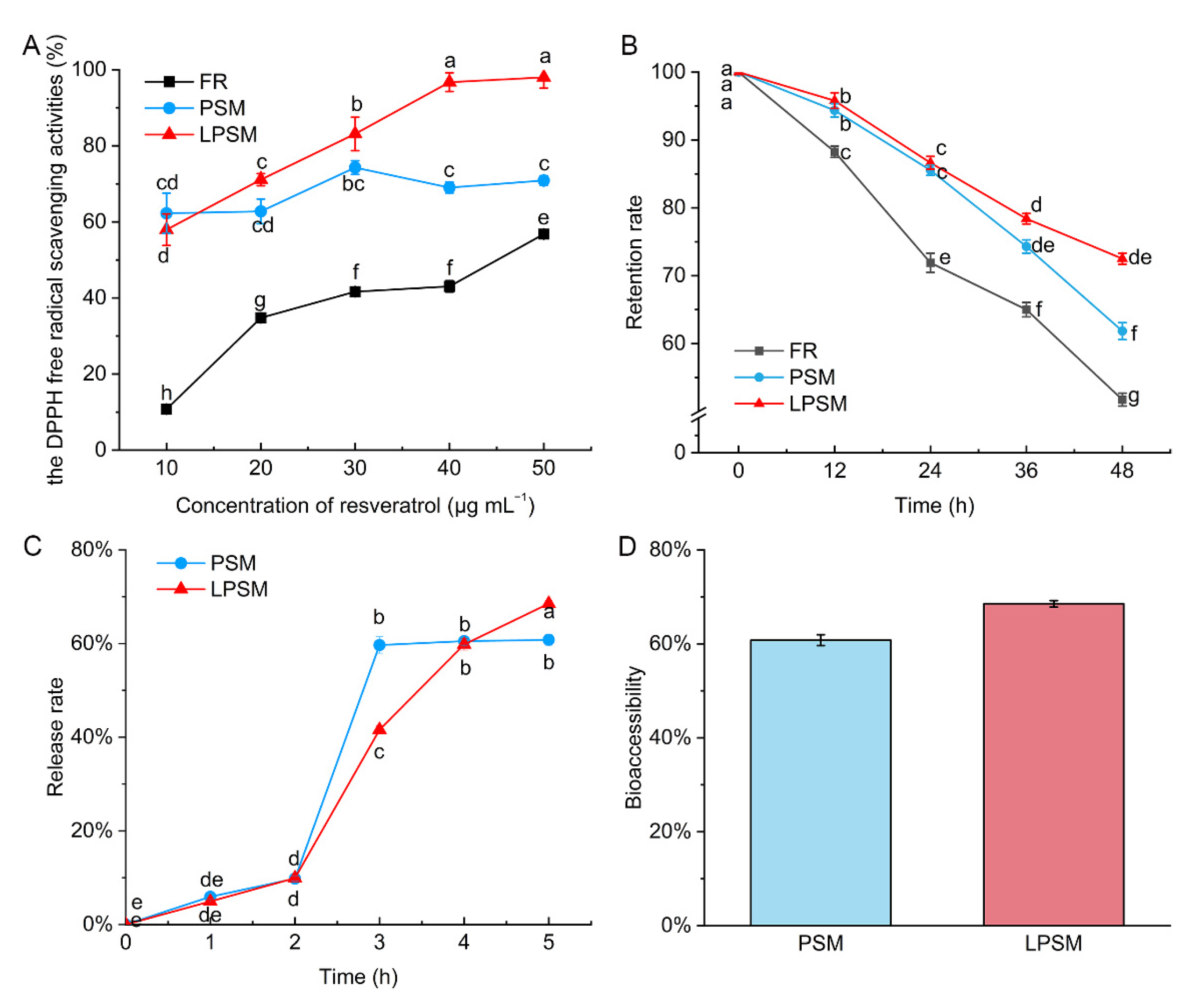Lecithin-Polysaccharide Self-Assembled Microspheres for Resveratrol Delivery
Abstract
:1. Introduction
2. Materials and Methods
3. Results and Discussion
3.1. Morphology of Resveratrol Microspheres
3.2. FTIR Analysis
3.3. Particle Size and Zeta Potential
3.4. Encapsulation Efficiency
3.5. Antioxidant Activity and UV Resistance
3.6. Release of Resveratrol In Vitro
4. Conclusions
Supplementary Materials
Author Contributions
Funding
Data Availability Statement
Acknowledgments
Conflicts of Interest
References
- Ramawat, K.G.; Merillon, J.M. (Eds.) Biological Effects. In Bioactive Molecules and Medicinal Plants; Springer: Berlin/Heidelberg, Germany, 2008; pp. 25–54. ISBN 978-3-540-74600-3. [Google Scholar]
- Fernandez, A.; Milton-Laskibar, I.; Gonzalez, M.; Portillo, M.P. Antiobesity Effects of Resveratrol: Which Tissues Are Involved? Ann. N. Y. Acad. Sci. 2017, 1403, 118–131. [Google Scholar] [CrossRef]
- Meng, T.; Xiao, D.; Muhammed, A.; Deng, J.; Chen, L.; He, J. Anti-Inflammatory Action and Mechanisms of Resveratrol. Molecules 2021, 26, 229. [Google Scholar] [CrossRef]
- Liu, D.; He, B.; Lin, L.; Malhotra, A.; Yuan, N. Potential of Curcumin and Resveratrol as Biochemical and Biophysical Modulators during Lung Cancer in Rats. Drug Chem. Toxicol. 2019, 42, 328–334. [Google Scholar] [CrossRef]
- Sun, Z.-M.; Guan, P.; Luo, L.-F.; Qin, L.-Y.; Wang, N.; Zhao, Y.-S.; Ji, E.-S. Resveratrol Protects against CIH-Induced Myocardial Injury by Targeting Nrf2 and Blocking NLRP3 Inflammasome Activation. Life Sci. 2020, 245, 117362. [Google Scholar] [CrossRef]
- Villaflores, O.B.; Chen, Y.-J.; Chen, C.-P.; Yeh, J.-M.; Wu, T.-Y. Curcuminoids and Resveratrol as Anti-Alzheimer Agents. Taiwan J. Obstet. Gynecol. 2012, 51, 515–525. [Google Scholar] [CrossRef]
- Davidov-Pardo, G.; McClements, D.J. Resveratrol Encapsulation: Designing Delivery Systems to Overcome Solubility, Stability and Bioavailability Issues. Trends Food Sci. Technol. 2014, 38, 88–103. [Google Scholar] [CrossRef]
- Allan, K.E.; Lenehan, C.E.; Ellis, A.V. UV Light Stability of Alpha-Cyclodextrin/Resveratrol Host-Guest Complexes and Isomer Stability at Varying PH. Aust. J. Chem. 2009, 62, 921–926. [Google Scholar] [CrossRef]
- Pinto, M.D.; Garcia-Barrado, J.A.; Macias, P. Oxidation of Resveratrol Catalyzed by Soybean Lipoxygenase. J. Agric. Food Chem. 2003, 51, 1653–1657. [Google Scholar] [CrossRef]
- Patel, K.R.; Scott, E.; Brown, V.A.; Gescher, A.J.; Steward, W.P.; Brown, K. Clinical Trials of Resveratrol. Ann. N. Y. Acad. Sci. 2011, 1215, 161–169. [Google Scholar] [CrossRef]
- Ahmadi, Z.; Mohammadinejad, R.; Ashrafizadeh, M. Drug Delivery Systems for Resveratrol, a Non-Flavonoid Polyphenol: Emerging Evidence in Last Decades. J. Drug Deliv. Sci. Technol. 2019, 51, 591–604. [Google Scholar] [CrossRef]
- Carvalho, I.T.; Estevinho, B.N.; Santos, L. Application of Microencapsulated Essential Oils in Cosmetic and Personal Healthcare—A Review. Int. J. Cosmetic Sci. 2016, 38, 109–119. [Google Scholar] [CrossRef]
- Özkan, G.; Bilek, S.E. Microencapsulation of Natural Food Colourants. Int. J. Food Sci. Nutr. 2014, 3, 145. [Google Scholar] [CrossRef]
- Leena, M.M.; Yoha, K.S.; Moses, J.A.; Anandharamakrishnan, C. Edible Coating with Resveratrol Loaded Electrospun Zein Nanofibers with Enhanced Bioaccessibility. Food Biosci. 2020, 36, 100669. [Google Scholar] [CrossRef]
- Jayan, H.; Leena, M.M.; Sundari, S.K.S.; Moses, J.A.; Anandharamakrishnan, C. Improvement of Bioavailability for Resveratrol through Encapsulation in Zein Using Electrospraying Technique. J. Funct. Food. 2019, 57, 417–424. [Google Scholar] [CrossRef]
- Sanna, V.; Roggio, A.M.; Siliani, S.; Piccinini, M.; Marceddu, S.; Mariani, A.; Sechi, M. Development of Novel Cationic Chitosan- and Anionic Alginate-Coated Poly(D,L-Lactide-Co-Glycolide) Nanoparticles for Controlled Release and Light Protection of Resveratrol. Int. J. Nanomed. 2012, 7, 5501–5516. [Google Scholar] [CrossRef]
- Al-Attar, T.; Madihally, S. Influence of Controlled Release of Resveratrol from Electrospun Fibers in Combination with SiRNA on Leukemia Cells. Eur. J. Pharm. Sci. 2018, 123, 173–183. [Google Scholar] [CrossRef]
- Bryla, A.; Lewandowicz, G.; Juzwa, W. Encapsulation of Elderberry Extract into Phospholipid Nanoparticles. J. Food Eng. 2015, 167, 189–195. [Google Scholar] [CrossRef]
- Huang, H.; Belwal, T.; Aalim, H.; Li, L.; Lin, X.; Liu, S.; Ma, C.; Li, Q.; Zou, Y.; Luo, Z. Protein-Polysaccharide Complex Coated W/O/W Emulsion as Secondary Microcapsule for Hydrophilic Arbutin and Hydrophobic Coumaric Acid. Food Chem. 2019, 300, 125171. [Google Scholar] [CrossRef]
- Coradini, K.; Lima, F.O.; Oliveira, C.M.; Chaves, P.S.; Athayde, M.L.; Carvalho, L.M.; Beck, R.C.R. Co-Encapsulation of Resveratrol and Curcumin in Lipid-Core Nanocapsules Improves Their in Vitro Antioxidant Effects. Eur. J. Pharm. Biopharm. 2014, 88, 178–185. [Google Scholar] [CrossRef]
- Balanc, B.; Trifkovic, K.; Dordevic, V.; Markovic, S.; Pjanovic, R.; Nedovic, V.; Bugarski, B. Novel Resveratrol Delivery Systems Based on Alginate-Sucrose and Alginate-Chitosan Microbeads Containing Liposomes. Food Hydrocoll. 2016, 61, 832–842. [Google Scholar] [CrossRef]
- Chaudhari, K.R.; Ukawala, M.; Manjappa, A.S.; Kumar, A.; Mundada, P.K.; Mishra, A.K.; Mathur, R.; Monkkonen, J.; Murthy, R.S.R. Opsonization, Biodistribution, Cellular Uptake and Apoptosis Study of PEGylated PBCA Nanoparticle as Potential Drug Delivery Carrier. Pharm. Res. 2012, 29, 53–68. [Google Scholar] [CrossRef]
- Huang, M.; Liang, C.; Tan, C.; Huang, S.; Ying, R.; Wang, Y.; Wang, Z.; Zhang, Y. Liposome Co-Encapsulation as a Strategy for the Delivery of Curcumin and Resveratrol. Food Funct. 2019, 10, 6447–6458. [Google Scholar] [CrossRef]
- Ahmad, M.; Gani, A. Ultrasonicated Resveratrol Loaded Starch Nanocapsules: Characterization, Bioactivity and Release Behaviour under in-Vitro Digestion. Carbohyd. Polym. 2021, 251, 117111. [Google Scholar] [CrossRef]
- Schaefer, B.; Hecht, M.; Harting, J.; Nirschl, H. Agglomeration and Filtration of Colloidal Suspensions with DVLO Interactions in Simulation and Experiment. J. Colloid Interface Sci. 2010, 349, 186–195. [Google Scholar] [CrossRef]
- Song, J.; Zong, J.; Ma, C.; Chen, S.; Li, H.; Zhang, D. Microparticle Prepared by Chitosan Coating on the Extruded Mixture of Corn Starch, Resveratrol, and Alpha-Amylase Controlled the Resveratrol Release. Int. J. Biol. Macromol. 2021, 185, 773–781. [Google Scholar] [CrossRef]
- Pu, S.; Li, J.; Sun, L.; Zhong, L.; Ma, Q. An in Vitro Comparison of the Antioxidant Activities of Chitosan and Green Synthesized Gold Nanoparticles. Carbohyd.Polym. 2019, 211, 161–172. [Google Scholar] [CrossRef]
- Vankayala, J.S.; Battula, S.N.; Kandasamy, R.; Mariya, G.A.; Franklin, M.E.E.; Pushpadass, H.A.; Naik, L.N. Surfactants and Fatty Alcohol Based Novel Nanovesicles for Resveratrol: Process Optimization, Characterization and Evaluation of Functional Properties in RAW 264.7 Macrophage Cells. J. Mol. Liq. 2018, 261, 387–396. [Google Scholar] [CrossRef]
- Zhang, Y.; Yu, Y.; Shi, X.; Zhao, S.; Chen, A.; Huang, D.; Niu, D.; Qin, Z. Study on the Preparation of Genipin Crosslinked Chitosan Microspheres of Resveratrol and in Vitro Release. J. Polym. Res. 2013, 20, 175. [Google Scholar] [CrossRef]




| Sample | Particle Size (μm) | Zeta Potential (mV) | Encapsulation Efficiency (%) |
|---|---|---|---|
| PSM | 6.422 ± 0.721 b | −21.18 ± 1.05 b | 65.45 ± 0.43 b |
| LPSM | 12.171 ± 0.960 a | −30.86 ± 1.37 a | 92.78 ± 0.82 a |
Publisher’s Note: MDPI stays neutral with regard to jurisdictional claims in published maps and institutional affiliations. |
© 2022 by the authors. Licensee MDPI, Basel, Switzerland. This article is an open access article distributed under the terms and conditions of the Creative Commons Attribution (CC BY) license (https://creativecommons.org/licenses/by/4.0/).
Share and Cite
Wang, L.; Lai, C.; Li, D.; Luo, Z.; Liu, L.; Jiang, Y.; Li, L. Lecithin-Polysaccharide Self-Assembled Microspheres for Resveratrol Delivery. Antioxidants 2022, 11, 1666. https://doi.org/10.3390/antiox11091666
Wang L, Lai C, Li D, Luo Z, Liu L, Jiang Y, Li L. Lecithin-Polysaccharide Self-Assembled Microspheres for Resveratrol Delivery. Antioxidants. 2022; 11(9):1666. https://doi.org/10.3390/antiox11091666
Chicago/Turabian StyleWang, Lei, Congting Lai, Dong Li, Zisheng Luo, Lingling Liu, Yunbin Jiang, and Li Li. 2022. "Lecithin-Polysaccharide Self-Assembled Microspheres for Resveratrol Delivery" Antioxidants 11, no. 9: 1666. https://doi.org/10.3390/antiox11091666
APA StyleWang, L., Lai, C., Li, D., Luo, Z., Liu, L., Jiang, Y., & Li, L. (2022). Lecithin-Polysaccharide Self-Assembled Microspheres for Resveratrol Delivery. Antioxidants, 11(9), 1666. https://doi.org/10.3390/antiox11091666









